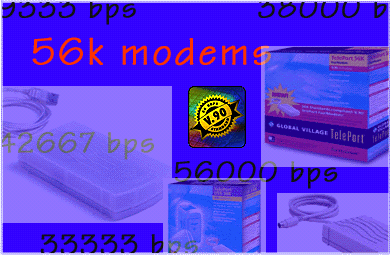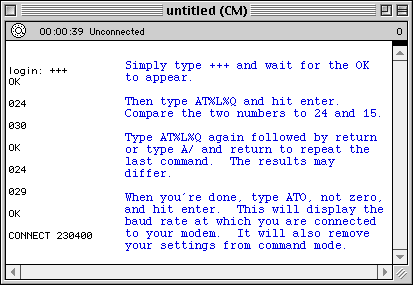

Mac 56k Modems - Diagnostics & Tips

So you have a 56k modem? Sure it is capable of connecting at 56,000 bytes per second, but do you really connect that fast? Many users are unable to connect at the top speeds, but do you know why? There are a few common reasons why. However, this time CCPlace is focusing on the quality of phone lines. If you pointed the blame at your ISP, perhaps you should point to your Telephone Company. Since the Telco doesn't support modem connection speeds over a few hundred bytes, they really don't care how fast you connect. The Telco simply focuses on voice. If you can generate and receive a phone call, your phone line is good. That simply just doesn't cut it for modem users.
Causes of poor quality phone lines:
There could be a large list of reasons why your phone line is considered poor quality. Some of the wires could get wet and make irritating cracking noises. Do you hear more noise when it rains? Maybe your Telco's central office is really far away. Then your signal would be a bit weaker. Perhaps your phone line has been split so many times that it is difficult to keep the signal. Many Telco technicians will place analog to digital converters on the line, to try to boost the signal. Somewhere before you receive the signal, there has to be a digital to analog converter. All these conversions will start killing 56k connections.
What to do:
To truly test your phone line, it can take some time and effort. You have to rule out possibilities that could influence your results. You want the most accurate results possible. You also want to test your equipment to see if the problem really is the phone line.
Note: If you have more than one phone line at your fingertips, you will be much better off.
Testing For Noise:
First you should test your phone line for noises. Plug a phone into the jack and dial 1. You will have some time before you hear the operator. Use this time to listen for noises. Those results could be influence by the phone you used. Do the same test with another phone or use that same phone on another phone line, if at all possible.
If you heard noises such as cracking, static, voices, etc., your Telco should fix that. Give them a call and tell them that you are having difficulty making calls. They shouldn't charge you anything, but they should send a technician to look at the line.
If you didn't hear noises, don't worry, your phone line can still be poor quality. Fixing it may be a bit more difficult though.
Using your modem to test phone line quality:
First off, to follow these directions almost exactly, you need to have a Rockwell chipset in your modem. Most of the popular modems have these, so you shouldn't have a problem. You can run a simple test to see if you have a Rockwell chipset or not.
Get set up to dial into your ISP's modem by using a terminal of some sort, not your usual PPP. If you have ClarisWorks, or AppleWorks, create a new Communications document. Select connection from the Settings menu and configure the set up for direct AT Commands. After that, select open connection from the Session menu. Now there should be a counter counting your connected time. Type AT&V and hit return.
If you see a screen full of hex code, stored profiles, etc., you have a Rockwell chipset. If you don't see this and see an ERROR, then you have a different chipset and you need to contact your modem manufacturer to get the correct AT Commands.
Now if you have a Rockwell chipset, you can move on with the tests. Close that Communications document and create a new one. Go into the connection window by selecting it from the Settings menu. This time configure it to dial into your ISP's modem, similar to how you use your PPP to dial in. Make sure you enter the phone number, select the modem type, chose the right port, etc. Click OK and then choose Open Connection from the Settings menu. Now your modem will dial into your ISP. Once it is connected, you should see a simple message on your screen. It will be followed by a line reading: login. Type +++ by using shift and the equals key. Soon after you finish that, OK should follow it. Now you're ready to type your commands. Type AT%L%Q and hit return. Two numbers should appear on your screen. These numbers tell you how your modem sees your telephone line. You can use them as a guide for quality. The first number is the Line Level in -dmb, and anything over 24 is considered poor. The second number is the Eye Quality Monitor Index, and anything over 15 is considered poor. Compare your results to these numbers. Are they within the good range? If not, how far past the poor range are they? You can type the AT%L%Q command many times, or a shortcut would be A/ to repeat the last command. Type it again and see if your results are consistent. They may range a bit. Once you're done, disconnect by choosing Close Connection from the Session menu. Then repeat the entire test again by reconnecting. Your results could be totally different depending on the quality of your line. You may even want to wait a little bit and try the test at a different time. You will definitely want to try this test more than once, to get an accurate reading. If you have a second phone line, plug your modem into that one and carry out these tests. Your results could be totally different. You could connect at much faster speeds, but it depends on the quality of the line.

Your results should appear as something similar to this. Notice that these results are very poor and as a result won't let you connect at fast speeds that your 56k modem is capable of.
So, if your results were good and you still have slow connect speeds, I'm not really sure what to say. But, that probably won't be too common. If you get poor results and have slow modem connect speeds, now you have to call your Telco. Tell them what is going on, that you have slow modem connect speeds and that you are blaming the phone line quality. You could try telling them about the test you performed, but they probably won't support it. They will also ask if you are having any trouble if you plug a phone into the jack and dial out. Tell them your results. The person that you speak with will probably run an MLT, but that test can be influenced by many simple actions. Then tell them that you would like a technician to take a look at the line. The technician can check if the line is 100% voice quality. Pursue them to send someone out to look at the line. Don't let them charge you for the technician's visit, you should be entitled to it. Tell them about the tests you did with your phone, modem, etc., if they are stubborn about sending someone to look at the line. Just try to have them send a technician.
Once a technician arrives, tell them the troubles that you are having. They will go and check the line for you. If there are any problems, they should fix it. If they don't find any problems, ask them if there is anyway that they can improve the line. Now go for the sensitive spot, ask them how fast they connect at their house. Most technicians have personal computers and are on the internet. If they connect fast, they might feel your pain. If they connect slow or don't have internet access, tell them about your weak connections. They might be able to do something or they might not, it depends on your situation.
Line 1 vs. Line 2: If one of your phone lines is better than the other, make sure that you are using the better one for your modem. If you use one for voice, and one for your computer, you can have the numbers switched so that you won't have to tell people your new telephone number. See if your Telco will do this without charging you a fee. They can tell you exactly how to do this process. If you don't want to switch the numbers, tell your Telco that you are getting different connections speeds on the two lines and that you know one is better than the other. Tell them that you want someone to take a look at the lines.

Final Words:
For more information you may want to check with your ISP or their website. They should be able to assist you for your specific situation. Depending on your Telco, they should be able to give you some information on the condition of your line. Telephone companies don't guarantee any speeds for their voice lines which are needed for 56k modems, but see if they can do something. Let them know how you feel and give them a piece of your mind.
You may have other internet connections available in your area, depending on where you reside. Bell's DSL line is a nice offering. Visit your regional Bell website to check for availability and information on DSL. Cable modems are also becoming more popular, so you can check with your cable TV provider to see if they offer this service to your area. Generally speaking, ISDN is a joke and you probably don't want to investigate that service. While DSL and cable connections have goods and bads, they should easily crush 56k modems many times. If you don't have any other connection available that is faster than 56k, you will just have to wait. There are more and more developments for faster connections, but when they will be deployed is unknown.
This page was published by the CCPlace Staff. No duplication of this page or any part of this site is permitted.